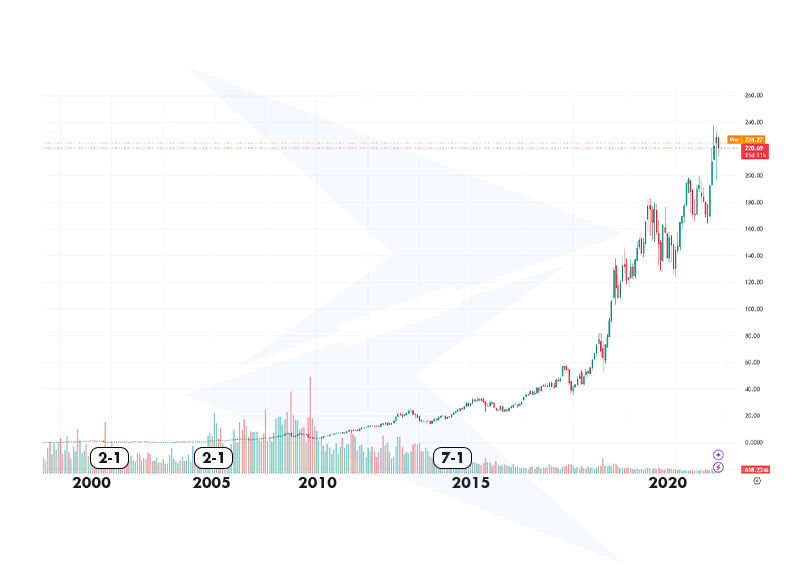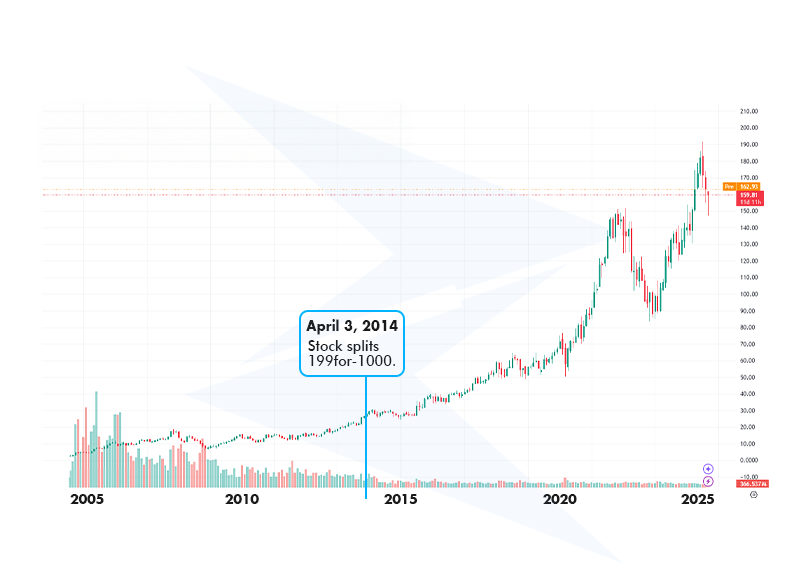
A stock split is when a company increases the number of its shares by dividing each existing share. Splitting the shares lowers the price per share but doesn’t change the overall value of the company. As a result, investors hold more shares, but each share’s individual value decreases.
The primary purpose of a stock split is to make shares more affordable for a wider range of traders.
For example, when a stock's price becomes very high, it can be difficult for smaller investors to buy in. A split lowers the share price, allowing more investors to purchase shares and potentially increasing the company's liquidity.
A stock split happens when a business divides its current shares in half using a predetermined ratio. For example, in a 2-for-1, each trader receives two new shares for every existing one. In this case, the number of shares doubles, but the price of each share is halved. The company's market value remains unaffected.
A stock split typically works like this: If a trader holds a $100 share and a 2-for-1 occurs, the investor will now have two shares worth $50 each. While the stock price decreases, the trader holds more shares, so the total portfolio value stays the same.
After the split, with more shares available in the market, the liquidity of the stock may increase. Additionally, the lower-priced shares can become attractive to a broader range of investors. Over time, the stock price may rise again, potentially offering investors more long-term gains.
Calculating a stock split is quite simple. Once the ratio is determined, the number of shares held by traders is multiplied by this ratio to find the new number of shares. Similarly, the share price decreases according to the split ratio.
For example, in a 2-for-1, if a trader holds 100 shares, the number of shares after the split will be 200. However, the price of each share will be halved. If the share price is $50, after the split, each share will be priced at $25.
In another example, in a 3-for-1, two new shares are added for every share investors hold. If an investor has 50 shares, this number will increase to 150 after the split. However, the share price will decrease by a third. For instance, if the share price is $90 per share, it will drop to $30 after the split.
An example of a stock split is Apple's 4-for-1 split in 2020. At that time, Apple's stock price was approximately $500. The company decided to split its shares to make them more accessible to a wider range of investors.
As a result of the 4-for-1, Apple's stock price dropped to around $125, while the number of shares owned by investors increased fourfold.

For instance, a trader holding 100 shares before the split now owns 400 shares after the split. However, the total investment value remained unchanged, as the price per share was reduced by a factor of four.
Another good example would be Google (Alphabet Inc). You can see how it affected the share price over years.

A stock split increases the number of outstanding shares while reducing the price per share. A reverse stock split, on the other hand, does the opposite. The company reduces the number of shares traded in the market while increasing the price per share.
For example, in a 1-for-2 reverse split, two shares held by investors are combined into one, doubling the stock price.
A reverse stock split is typically done when a stock’s price is very low, with the aim of meeting the minimum exchange requirements.
Neither of these actions changes the company’s market value, but they can have different impacts on investor sentiment and stock movements.
Do split stocks rise or fall?
After a stock split, the share price technically decreases because each share is revalued according to the split ratio. For example, in a 2-for-1 stock split, the share price is halved. However, demand for the stock may increase after the split, which can cause the price to rise again in the long term.
What happens if I own shares that undergo a stock split?
If you own shares that are subject to a split, the number of shares you own will increase according to the split ratio. For example, in a 2-for-1, if you own 100 shares, after the split, you'll have 200 shares, but the total value of your portfolio remains unchanged.
Does the stock split make the company more or less valuable?
A stock split does not change the company's market value. It only reduces the price per share and increases the total number of shares. The overall value of the company remains the same; the split just makes the stock more accessible.
When do stock prices recover after a stock split?
The recovery of stock prices after a split depends on market conditions and investor interest. After the split, the lower share price may attract more investors, which can cause the stock price to rise over time. However, this process usually takes a few weeks to a few months.
Is there a connection between stock splits and stock performance?
A stock split does not directly impact stock performance. However, the increased investor interest after the split may drive demand, leading to a rise in stock prices in the long term. Nonetheless, this is not always guaranteed, as market conditions play a key role.
Is a stock split beneficial for long-term investors?
A stock split can be beneficial for long-term investors, as a lower stock price may attract more investors, potentially boosting prices over time. Additionally, owning more shares after a split could lead to increased dividends in the future, contributing to long-term returns.
Do stock splits affect a company’s earnings?
A stock split does not directly affect a company’s earnings. It only increases the number of shares and lowers the price per share. The company’s financial performance and revenue remain unchanged, but increased investor interest after a split can indirectly support long-term performance.
Which companies frequently do stock splits?
Companies experiencing rapid growth and whose share prices are rising quickly often opt for stock splits. Companies like Apple, Tesla, and Microsoft have split their stocks multiple times in the past. The goal is to make the stock more affordable and attract more investors.
When are stock splits announced and how do they happen?
Stock splits are usually decided by a company’s board of directors and then publicly announced. The company sets the date and ratio for the split and informs investors. After the split, the number of shares and the share price are automatically adjusted based on the split ratio.
How does a stock split affect earnings per share (EPS)?
After a stock split, earnings per share (EPS) decrease according to the split ratio. Since the number of shares increases but the company's total earnings remain the same, the EPS is reduced. For example, in a 2-for-1 split, EPS is halved, but total earnings remain constant.
How does a stock split affect trader psychology?
A stock split can increase trader interest. Lower-priced shares become more attractive to a broader range of investors, increasing trading volume and liquidity. Additionally, traders may buy after the split, hoping for a price increase in the near future.
 Introduction to cTrader: The Quick Setup Every Trader Should Know
Introduction to cTrader: The Quick Setup Every Trader Should Know
Let's turn the default cTrader view into a workspace that matches how you trade with practical watchlists, default chart templates, and order ticket settings.
Detail Choosing a Broker for Gold Trading
Choosing a Broker for Gold Trading
What to Consider When Choosing a Broker for Gold? In this guide, we will look at the decision-making process from a trader’s eyes.
Detail Historical Movements of Gold: What to expect in 2026?
Historical Movements of Gold: What to expect in 2026?
Will gold continue rising in 2026? Explore key drivers, past trends, and three realistic scenarios shaping next year’s gold outlook.
DetailThen Join Our Telegram Channel and Subscribe Our Trading Signals Newsletter for Free!
Join Us On Telegram!